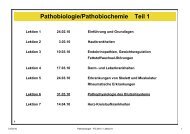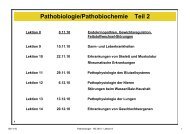Pathobiologie/Pathobiochemie Teil 2 - Alex Eberle
Pathobiologie/Pathobiochemie Teil 2 - Alex Eberle
Pathobiologie/Pathobiochemie Teil 2 - Alex Eberle
Sie wollen auch ein ePaper? Erhöhen Sie die Reichweite Ihrer Titel.
YUMPU macht aus Druck-PDFs automatisch weboptimierte ePaper, die Google liebt.
Corona-Viren<br />
Replication of the coronaviruses occurs in the cytoplasm.<br />
Most human coronaviruses do not grow in cultured cells, therefore<br />
relatively little is known about them, but two strains (229E & OC43)<br />
grow in some cell lines and have been used as a model. Replication<br />
is slow compared to other enveloped viruses, e.g. 24 h c.f. 6-<br />
8 h for influenza. Entry occurs via endocytosis and membrane<br />
fusion (probably mediated by E2).<br />
18<br />
Initially, the 5' 20kb of the (+)sense genome is translated to produce a viral polymerase, which then produces a fulllength<br />
(-)sense strand (this step is poorly understood). This is used as a template to produce mRNA as a 'nested set'<br />
of transcripts, all with an identical 5' non-translated leader sequence of 72nt & coincident 3' polyadenylated ends:<br />
Each mRNA is monocistronic, the genes at the 5' end being translated from the longest mRNA and so on. These<br />
unusual cytoplasmic structures are produced not by splicing (post-transcriptional modification) but by the polymerase<br />
during transcription. Between each of the genes there is a repeated intergenic sequence - UCUAAAC - which<br />
interacts with the transcriptase plus cellular factors to 'splice' the leader sequence onto the start of each ORF.<br />
28/04/10 <strong>Pathobiologie</strong> - FS 2010 - Lektion 9 18





